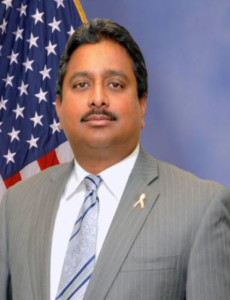
Army PEO-EIS takes on toughest IT modernization tasks
Hari Bezwada, the chief information officer of the Army’s Program Executive Office-Enterprise Information System, said he’s taking measured approach to migrate...
The Army’s Program Executive Office-Enterprise Information System is taking on one of the most difficult technology upgrades and finding success.
PEO-EIS is leading the migration of multiple enterprise resource planning (ERP) systems to a DoD provider.

Hari Bezwada, the chief information officer of the Army’s PEO-EIS, said his organization plans to shift five business systems to the Defense Information Systems Agency. He said two of the five are in process and already achieved initial operating capability in July.
“We are working with the Defense Logistics Agency and the Air Force to create a center of excellence for the ERP systems,” he said. “It’s very hard to find highly talented people, who know Oracle or SAP and all those things, to take care of the systems. It’s a lot easier when you consolidate into center of excellences.”
Bezwada said the other three systems will migrate to DISA by 2018.
“We’ve selected two locations and we are moving our stuff there,” he said. “We came up with the architecture for how to reduce over 1,000 computers in this migration as well because the better we consolidate and shrink it down, the more we could save on the per license cost, but it also helps us reduce the security posture by reducing the number of units we have to deal with.”
Bezwada said the second step after initial migration is to virtualize the servers as part of that consolidation.
“One of the first things we wanted to do is with a new target architecture, we put that equipment at the current location, migrated and made sure it was doable. Once we got that confirmation, we then worked with DISA to standup the environment. It’s analogous to building a house. Somebody built a brand new house and gives you the keys, now you bring in the furniture. We are in the state of trying to bring in our system from one location to DISA.”
Related to moving ERPs systems to a government cloud, Bezwada said PEO-EIS is looking at how the military can take advantage of commercial cloud services.
He said PEO-EIS is analyzing how best to create the contracts to make it easier for military services or agencies to move to the cloud.
“We are absolutely committed to the cloud, like most of our functional communities. What I see as the biggest challenge is the culture. We are used to having this big document sitting with us and checking a thousand things. We have to shed some things. The Federal Risk Authorization Management Program (FedRAMP) is the new standard of doing things. Once it’s approved at FedRAMP, we shouldn’t be putting them through the same ringer to pass. Not everyone can get there by themselves through separate contracts. If Amazon had to do one with every organization that is interested, it’s impractical for them to be successful,” Bezwada said. “PEO-EIS is looking at creating umbrella contracts that individual organizations can take advantage of so we don’t have to keep doing those individually.”
Bezwada said PEO-EIS has a separate program manager for this program and is actively working through the requirements.
Related to the cloud effort, PEO-EIS is expanding its mobile presence.
Bezwada said his office is has three initiatives related to mobility: making sure the infrastructure is prepared, improving the WiFi to reach the user areas and moving traditional desktop applications to a mobile environment.
Related Stories
“When you have a clerk who wants to order a part as a logician, he shouldn’t have to have the entire interface available on the mobile device. He just needs to know what his role is and download only the apps he needs,” he said. “It does two things for us. One is, it becomes manageable for front end changes when software changes, and second thing is cost controls because the user doesn’t have to be trained on everything.”
Bezwada said PEO-EIS is making sure the bases are connected by 100 gigabyte communications, and a 10G to the edge or to the building and WiFi traveling on that 10G connection.
“That is the big architecture thing we are focusing on,” he said. “We also are looking at doing some pilots with the WiFi architecture to see how successful it would be for unclassified and classified sides. It’s all about reducing the costs and giving more capabilities to our users.”
Bezwada said he’s also working on improving data analytics in a specific area. He said Army PEO-EIS already has good business intelligence and analytics because those capabilities come with the ERPs. The Army will get good security intelligence and analytics by implementing the Joint Regional Security Stacks (JRSS).
But Bezwada said it’s around operational intelligence and analytics where PEO-EIS needs to focus on. He said that means moving toward a combination of better tools and better processes.
Copyright © 2025 Federal News Network. All rights reserved. This website is not intended for users located within the European Economic Area.
Jason Miller is executive editor of Federal News Network and directs news coverage on the people, policy and programs of the federal government.
Follow @jmillerWFED




